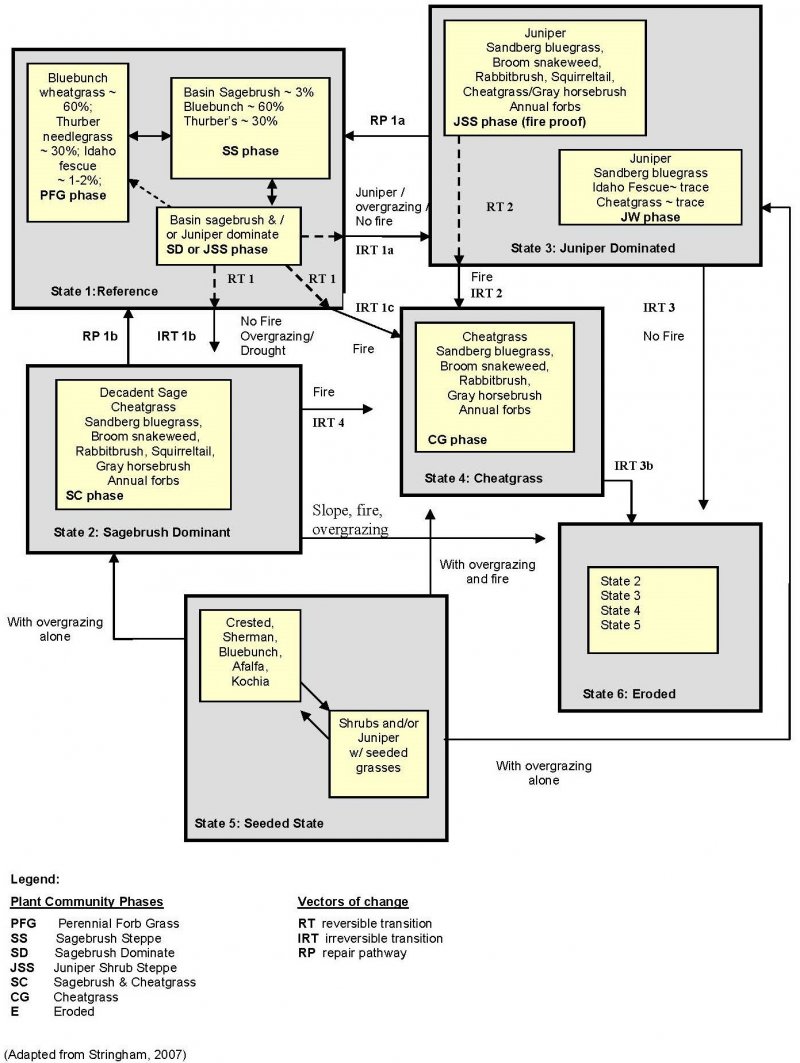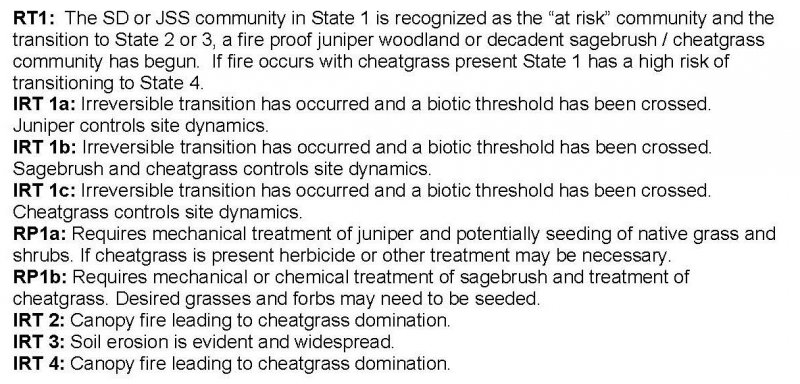Ecological dynamics
The reference plant community is dominated by bluebunch wheatgrass. Needlegrasses are common in the stand. With an increase in coarse fragments in the soil or with coarse surface textures, there is an increase in the proportion of needlegrasses. Western juniper may increase in the absence of fire, particularly at the upper end of the precipitation range.
Ecological Dynamics:
Disturbance outside the normal range of variability may cause a decrease in bluebunch wheatgrass, the preferred perennial bunchgrass on this site. As bluebunch wheatgrass declines, Sandberg’s bluegrass increases along with shrub/tree species such as sagebrush and juniper. The potential for cheatgrass invasion is increased as the site deteriorates (State 1). The Juniper Shrub Steppe and Sagebrush Dominant phases within State 1 are recognized as the “at risk” plant communities. Phases are included in the model diagram image.
Multiple pathways of change from State 1 Juniper Shrub Steppe phase exist. If fire is suppressed juniper will continue to expand and out-compete both the bunchgrass and sagebrush understory. When fine fuels are reduced to the point where fire no longer will carry, the site has crossed a threshold and transitioned to State 3 with no way for restoration; Juniper Shrub Steppe phase (fireproof). Cheatgrass can invade these ecological sites and with inappropriate grazing will likely be found under the juniper canopy. The Juniper Shrub Steppe phase within State 3 has the potential to transition to State 4 with a canopy fire. Maturation of the juniper community within State 3 leads to a juniper woodland with no more than a trace amount of sagebrush and deep-rooted perennial bunchgrasses. Juniper controls nutrient cycling, energy capture and water use (State 3 Juniper Woodland phase). The potential for soil erosion increases as the juniper woodland matures and the understory plant community cover declines. The risk of an irreversible transition over an abiotic threshold to the Juniper Woodland erosional phase of State 6 increases with increasing slope and increasing bare ground.
With no fire, overgrazing and/or severe drought within State 1 Juniper Shrub Steppe phase the perennial bunchgrasses will continue to decline while cheatgrass abundance increases and sagebrush matures further facilitating the decline in bunchgrass. This feedback continues until sagebrush and cheatgrass control stand dynamics (State 2). Fire within this community can trigger an irreversible transition to State 4. The potential for soil erosion increases as the sagebrush community matures and the understory plant community cover declines. The risk of an irreversible transition over an abiotic threshold to the erosional phase of State 6 increases with increasing slope and increasing bare ground.
When this site is seeded (typically to non-native grass and forb communities), abusive grazing can cause the seeded State 5 to transition either to a decadent sagebrush cover type or a juniper dominated system. With abusive grazing and fire the seeded rangeland has the potential to convert to State 4.
Treatment Response:
This site lack resilience to disturbance primarily due to the characteristic annual precipitation of less than 12 inches along with south exposure and droughty soils. The restoration pathway from State 3 to State 1 indicates potential for rehabilitation of the juniper controlled plant community exists. The potential for success is limited. Treatment of juniper should incorporate methods to provide soil cover to facilitate microsites for seedling establishment along with seeding of bluebunch wheatgrass, forbs and sagebrush. Fire is not a recommended tool of rehabilitation due to the increased risk presented by cheatgrass presence. Restoration pathway from State 2 to 1 captures that the treatment of the Sagebrush and Cheatgrass phase would require chemical or mechanical control of the sagebrush and cheatgrass along with seeding. The potential for failure of rehabilitation projects on this site is high. Every effort should be made to prevent threshold forcing events from occurring.
(Adapted from Stringham, 2007)
State 1
Reference State
Community phases are maintained by fire and are not negatively affected by appropriate grazing. Inappropriate grazing, reduced fire frequency or both lead to increased sagebrush and juniper cover and decreased cover of understory species, however the Sagebrush Dominant or Juniper Shrub Steppe community phase is still susceptible to fire. In addition, due to the south facing aspect and shallow soil typical of this ecological site, the risk of cheatgrass invasion with inappropriate grazing is significant. Sites exhibit low resilience to disturbance.
Community 1.1
Reference - Perennial Forb Grass
The Reference Plant Community is dominated by bluebunch wheatgrass. Needlegrasses are common in the stand. Vegetative composition of the community is approximately 90 percent grasses, 8 percent forbs, and 2 percent shrubs.
Table 5. Annual production by plant type
| Plant type |
Low
(kg/hectare) |
Representative value
(kg/hectare) |
High
(kg/hectare) |
| Grass/Grasslike |
751 |
936 |
1126 |
| Forb |
78 |
101 |
123 |
| Shrub/Vine |
56 |
67 |
78 |
| Tree |
11 |
17 |
17 |
| Total |
896 |
1121 |
1344 |
Community 1.2
Sagebrush Steppe
Basin big sagebrush is approximately 3 percent of the community with bluebunch wheatgrass at 60 percent and Thurber's needlegrass is approximately 30 percent.
Community 1.3
Sagebrush Dominant or Juniper Shrub Steppe
Basin big sagebrush and Juniper dominant.
Pathway 1.1A
Community 1.1 to 1.2
Pathway 1.2A
Community 1.2 to 1.1
Pathway 1.2B
Community 1.2 to 1.3
Pathway 1.3A
Community 1.3 to 1.1
Pathway 1.3B
Community 1.3 to 1.2
State 2
Sagebrush Dominant
Recognized by the need to mechanically or chemically treat the sagebrush. The presence of cheatgrass and site characteristics indicate prescribed burning as an extreme risk. Sagebrush and Cheatgrass phase with sagebrush dominant, bareground interspaces with a trace of bluebunch wheatgrass under the brush canopy and an increase in Sandberg bluegrass, broom snakeweed and rabbitbrush.
Community 2.1
Sagebrush and Cheatgrass
Decadent sagebrush with cheatgrass, Sandberg bluegrass, broom snakeweed squirreltail, gray horsebrush, and annual forbs.
State 3
Juniper Dominant
Recognized by the need to mechanically treat the juniper woodland. The presence of cheatgrass and site characteristics indicate prescribed burning as an extreme risk. Juniper Shrub Steppe phase with Juniper dominant, bareground interspaces with a trace of bluebunch wheatgrass under the tree canopy and an increase in Sandberg bluegrass. Sagebrush is stressed and dying (Juniper Shrub Steppe phase). As the juniper woodland matures, sagebrush and bluebunch wheatgrass are eliminated and the potential for soil erosion increases (Juniper Woodland phase).
Community 3.1
Juniper Shrub Steppe (Fire Proof)
Juniper, Sandberg bluegrass, broom snakeweed, rabbitbrush, squirreltail, cheatgrass, gray horsebrush, and annual forbs.
Community 3.2
Juniper Woodland
Juniper, Sandberg bluegrass, trace of Idaho fescue, and a trace of cheatgrass.
State 4
Cheatgrass
Cheatgrass dominated state maintained through frequent fire.
[For this site: cheatgrass can be interpreted to mean any invasive annual grass (e.g. medusahead, ventenata). Soil textures with higher clay percentages have higher susceptibility to medusahead.]
Community 4.1
Cheatgrass
Cheatgrass, Sandberg bluegrass, broom snakeweed, rabbitbrush, gray horsebrush, and annual forbs.
State 5
Seeded
State 5 is a common occurrence on many ecological sites therefore it has been included in the model. Overgrazing of the seeded rangeland can cause a reduction in deep rooted perennial grasses in favor of Sandberg bluegrass, cheatgrass, sagebrush and juniper. State 5 can transition to any of the other alternative states with inappropriate grazing, fire, or both.
Community 5.1
Seeded Grass Dominant
Crested wheatgrass, Sherman, bluebunch wheatgrass, alfalfa, and Kochia.
Community 5.2
Shrub and Seeded Grasses
Shrubs and juniper with seeded grasses.
Pathway 5.1A
Community 5.1 to 5.2
Pathway 5.2A
Community 5.2 to 5.1
State 6
Eroded
Eroded version of State 2, 3, 4 or 5. The site has crossed an abiotic threshold characterized by soil loss and lack of seedbank thereby resulting in the inability to sustain the establishment of perennial plants including juniper. All ecological processes, hydrologic cycle, nutrient cycle and energy capture have been significantly changed.
Community 6.1
Eroded State-shift Dependant
Community dynamic is based on what state (State 2, 3, 4, or 5) the community that has shifted across the threshold.
Transition T1A
State 1 to 2
Grazing management favoring shrubs and/or severe drought will reduce the perennial bunchgrasses in the understory.
Transition T1B
State 1 to 3
Less frequent fire and/or extended drought reduces perennial bunch grasses and allows for an increase in shrub/tree species.
Transition T1C
State 1 to 4
Catastrophic fire, multiple fires, and/or soil disturbing treatments/activities in the presence of invasive species
Restoration pathway R2A
State 2 to 1
Requires mechanical treatment of juniper and potentially seeding of native grass and shrubs. If cheatgrass is present herbicide or other treatment may be necessary.
Transition T2A
State 2 to 4
Catastrophic fire, multiple fires, and/or soil disturbing treatments/activities.
Transition T2B
State 2 to 6
Chronic, heavy growing season grazing. Severe fire likely following shrub and tree fuel accumulation.
Restoration pathway R3A
State 3 to 1
Juniper stand removal and seeding of desired cultivated species: herbicide may be necessary
Transition T3A
State 3 to 4
Catastrophic fire and/ or failed rehabilitation treatment or combination of both. Inappropriate grazing management in the presence of annual non-native species.
Transition T3B
State 3 to 6
Chronic, heavy growing season grazing. Severe fire likely following shrub and tree fuel accumulation.
Transition T4A
State 4 to 6
Chronic, heavy growing season grazing. Severe fire.
Restoration pathway R5A
State 5 to 2
Chronic, heavy growing season grazing will decrease bunchgrasses, increase Sandberg bluegrass and shrubs.
Transition T5A
State 5 to 3
Time without disturbance allows for trees to outcompete understory
Transition T5B
State 5 to 6
With overgrazing alone.


